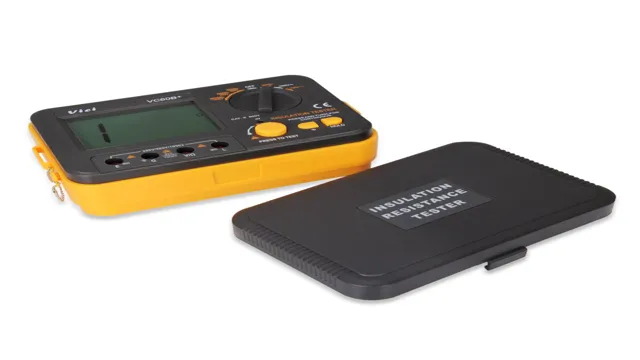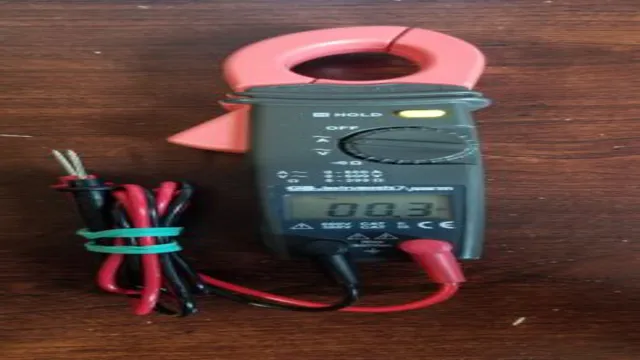Have you ever encountered an electrical issue in your home, but hesitated to reach for a voltage tester because you weren’t sure how to use it properly? Don’t worry, you’re not alone. Many homeowners are intimidated by electrical work, but with the right tools and knowledge, you can safely and confidently diagnose and fix issues. One tool that every DIY electrician should have in their arsenal is the GB Instruments voltage tester.
In this blog, we’ll walk you through the steps of using a GB Instruments voltage tester, so you can feel confident and informed the next time you need to tackle an electrical problem.
Overview
If you’re working in the electrical industry or simply need to test the voltage in your home, you may come across a GB Instruments voltage tester. This tool is easy to use, and it’s important to understand the steps to ensure both accuracy and safety. First, make sure the voltage tester is switched to the voltage range you need (AC or DC).
Then, insert the tester probes into the outlet or wiring you’re testing. If the tester lights up or beeps, that means there’s an electrical current, and you should exercise caution. If there’s no response, the outlet or wiring is not active, and it’s safe to work on.
Make sure to store the voltage tester in a safe and dry location to ensure longevity and accuracy. Overall, using a GB Instruments voltage tester is an essential tool for anyone dealing with electrical work, and understanding how to properly use it can save both time and potential hazards.
Understanding Voltage Testers
Voltage testers are essential tools used in the electrical industry to ensure your safety when working with electricity. Voltage testers are simple tools that can help you determine whether electricity is flowing through a circuit or not. These devices work by measuring electrical potential difference (voltage) between two points in an electrical circuit.
By using a voltage tester, you can easily find out if there is any voltage in a circuit, and whether it is safe to work with or not. It is important to note that voltage testers come in different types, and each type is designed for a specific purpose. Some of the common types of voltage testers include non-contact testers, digital testers, and analog testers.
It is essential to choose the right voltage tester for the job you are doing and use it correctly to avoid any accidents or injuries. By using a voltage tester properly, you can ensure your safety and the safety of others while working with electrical circuits.

Safety Precautions
As we go about our daily lives, safety should always be a top priority. Whether at home, work, or in any other environment, there are potential hazards that we need to be aware of and take precautions to avoid. Safety measures are put in place to reduce the risk of accidents and injuries, and it’s important that we follow them to protect ourselves and those around us.
From wearing appropriate attire to following established procedures, there are steps we can take to stay safe in any situation. By being conscientious and taking the necessary precautions, we can help ensure that we stay healthy and injury-free. So, let’s remember to always keep safety in mind, no matter where we are or what we’re doing.
Testing Voltage
If you are wondering how to use a GB Instruments voltage tester, you have come to the right place. These tools are essential for anyone working with electrical appliances or wiring. To begin, you must ensure that the voltage tester is working correctly.
You can do this by touching the probes together and verifying that the tester beeps or lights up. Once your tool is working, you can start testing voltage. Begin by switching off the power source to the circuit you want to test.
Insert the probes at the location of your choosing; ensure they make contact with the conductors. If the tester lights up or beeps, it means there is voltage present. You can then move from one point to another until you identify the voltage source.
Do not forget to switch the power back on once you are done testing. With these easy steps, you can now test voltage using a GB Instruments voltage tester.
Preparing the Voltage Tester
Preparing the voltage tester is an important step before testing any electrical device. First, make sure that the tester is functioning correctly by checking its batteries and leads. Once confirmed, switch on the tester and set it to the appropriate range for the voltage you will be testing.
Place one lead at the point where you will test the voltage, while the other lead is grounded. If the device you are testing is already connected to a power source, ensure that it is switched on. When you touch the test point with the lead, the voltage reading will show up on the tester.
Remember, safety always comes first, so ensure that you are not touching any part of the device while testing and that you are adequately grounded. By following these simple steps, you can be assured of the correct voltage measurement and preventing accidents.
Testing AC Voltage
Testing AC voltage is an essential step in ensuring the safety and reliability of your electrical system. To test AC voltage, you will need a voltage tester, which can be either a digital or analog one. Before conducting the test, ensure that the power source is turned off and that the tester is working correctly.
Once you have confirmed these initial steps, touch the probe of the tester to the wire that you want to test. The tester should show a reading indicating the voltage. This reading will help you determine whether the voltage level is safe or dangerous.
Remember, if the reading is higher than expected, do not proceed with any electrical work until you have identified the cause of the higher voltage. Testing AC voltage requires skill and experience, so if you are unsure of how to do it correctly, seek professional help.
Testing DC Voltage
If you’re working with electronics, it’s important to know how to test DC voltage. This allows you to ensure that your circuits are working properly and that there is no danger of electrical shock. To test DC voltage, you’ll need a multimeter, which is a device that can measure various electrical properties.
First, set the multimeter to DC voltage mode and select the appropriate voltage range for your circuit. Then, connect the multimeter probes to the circuit, making sure the red probe is connected to the positive side and the black probe to the negative side. Finally, read the voltage value on the multimeter display.
If the voltage is within the expected range, then your circuit is working correctly. If the voltage is too high or too low, check your circuit for any issues or defects. Testing DC voltage is a simple process, but it’s an important step in ensuring the safety and functionality of your electronic devices.
Interpreting Results
If you’re wondering how to use a GB Instruments voltage tester to interpret results, you’ve come to the right place. First, make sure the tester is properly calibrated and the batteries are fresh. Then, insert the testing leads into the appropriate sockets on the tester and turn it on.
Touch the leads to the wires or terminals you want to test, making sure they’re firmly attached and not likely to come loose. The tester will display the voltage and polarity of the circuit you’re testing. If the voltage falls within the expected range and the polarity is correct, the circuit is working properly.
If not, you may need to investigate further to identify and fix any issues. Remember to always be cautious and follow safety guidelines when working with electricity. With a bit of practice and attention to detail, using a GB Instruments voltage tester can be a useful tool for troubleshooting electrical problems.
Understanding Voltage Readings
Understanding voltage readings can be quite perplexing for those who are not familiar with electrical systems. However, interpreting the results is not as complex as it may seem. A voltage reading simply measures the potential difference between two points in a circuit.
In simpler terms, it tells you how much electrical energy is flowing from one point to another. When analyzing voltage readings, it is essential to take note of the units being used. Voltages are usually measured in volts (V) or millivolts (mV).
A high voltage reading may indicate that there is too much electrical energy flowing through the circuit, which may cause damage or, in some cases, pose a safety hazard. In contrast, a low voltage reading may indicate that there is an insufficient amount of electrical energy flowing through the circuit. This could lead to poor performance or, in some cases, equipment failure.
Understanding how to interpret voltage readings is crucial for ensuring the safety and proper functioning of electrical systems.
Troubleshooting Common Issues
When troubleshooting common issues, interpreting results is an essential skill to have. It can be frustrating when something doesn’t work as expected, but understanding the data can help determine the cause of the problem. Take a step back and analyze the results with a fresh perspective.
Identify any patterns or trends that may indicate the root of the issue. It’s crucial to remain calm and patient, as quick assumptions and rash decisions can lead to further problems. Additionally, don’t hesitate to seek assistance from colleagues or online resources if needed.
Remember, interpreting results is not a one-time skill, but rather a process that requires constant practice to become proficient. By doing so, you can save time and frustration by resolving issues efficiently.
Conclusion
So, there you have it! Using a GB Instruments voltage tester is a breeze, just like blowing out birthday candles or hitting a home run. With a few simple steps, you can determine if there’s voltage present or not, giving you the power to take control of any electrical situation. So why wait? Take the plunge and become a master electrician using your very own GB Instruments voltage tester.
Who knows, you might just shock yourself at how electric you really are!”
FAQs
What is a GB Instruments voltage tester?
A GB Instruments voltage tester is a tool used to measure electrical voltage in a circuit or device.
How do I use a GB Instruments voltage tester?
To use a GB Instruments voltage tester, first, ensure it is properly calibrated and connected to a source of electricity. Then, touch the tester’s probes to the circuit or device you want to measure and read the voltage measurement on the tester’s display.
Is it safe to use a GB Instruments voltage tester?
Yes, it is safe to use a GB Instruments voltage tester as long as you follow the manufacturer’s instructions and exercise caution. Always turn off power to the circuit or device before testing and wear appropriate safety gear, such as gloves and eye protection.
What types of voltage can a GB Instruments voltage tester measure?
A GB Instruments voltage tester can typically measure AC and DC voltage up to a certain range, depending on the model.
Can a GB Instruments voltage tester test for electrical continuity?
Yes, some GB Instruments voltage tester models have a continuity function that tests for electrical continuity in a circuit or device.
What should I do if I get a dangerous or unexpected voltage reading on my GB Instruments voltage tester?
If you get a dangerous or unexpected voltage reading on your GB Instruments voltage tester, immediately turn off power to the circuit or device and seek the assistance of a qualified electrician.
How often should I calibrate my GB Instruments voltage tester?
It is recommended to calibrate your GB Instruments voltage tester annually or whenever it is dropped or damaged to ensure accurate readings.






